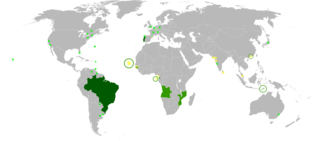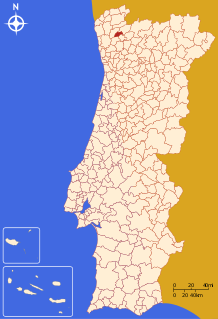
Vila do Conde is a municipality in the Norte Region of Portugal. The population in 2011 was 79,533, in an area of 149.03 km². The urbanized area of Vila do Conde, which includes the parishes of Vila do Conde, Azurara and Árvore, represent 36,137 inhabitants. Vila do Conde is interlinked to the north with Póvoa de Varzim, forming a single urban agglomeration. The town is on the Portuguese Way of the Camino de Santiago.
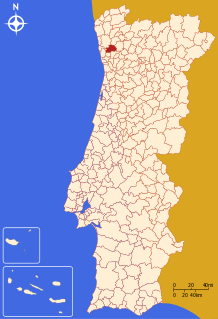
Vila Nova de Famalicão is a town and municipality in the district of Braga, in the north of Portugal. The population in 2011 was 133,832, in an area of 201.59 km².
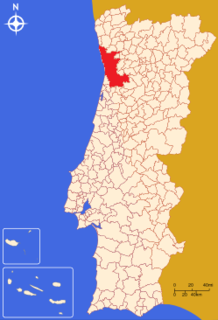
Porto Metropolitan Area is a metropolitan area in coastal northern Portugal which covers 17 municipalities, including the City of Porto, making up the second biggest urban area in the country. Porto Metropolitan Area was created in 1991. It is a union of metropolitan municipalities, comprising both former Grande Porto Subregion and Entre Douro e Vouga Subregion which were two NUTS III subdivisions as well as parts of Ave Subregion and Tâmega Subregion. The population in 2011 was 1,759,524 in an area of 2,040.31 km². Currently the most populous municipality is Vila Nova de Gaia, which is located on the South side of the Douro River, on the opposite side of Porto.
Vila Nova may refer to the following places:
Bente is a former civil parish in the municipality of Vila Nova de Famalicão in the Minho region, Portugal. In 2013, the parish merged into the new parish Carreira e Bente. Its surface area is 1.30 km² and its population, in 2001, was 959.

The district of Braga is a district in the northwest of Portugal. The district capital is the city of Braga, and it is bordered by the district of Viana do Castelo in the north, Vila Real in the east, Spain (Galicia) in the northeast and Porto in the south. Its area is 2,673 km² and it has a population of 831,368.

Norte or Northern Portugal is the most populous region in Portugal, ahead of Lisboa, and the third most extensive by area. The region has 3,689,173 inhabitants according to the 2011 census, and its area is 21,278 km². It is one of five regions of Mainland Portugal. Its main population center is the urban area of Porto, with about one million inhabitants; it includes a larger political metropolitan region with 1.8 million, and an urban-metropolitan agglomeration with 2.99 million inhabitants, including Porto and a number of urban areas in Northwestern Portugal, ranging from Braga to Aveiro. The Commission of Regional Coordination of the North (CCDR-N) is the agency that coordinates environmental policies, land-use planning, cities and the overall development of this region, supporting local governments and associations.
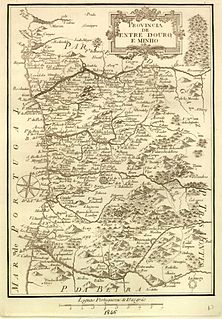
Entre Douro e Minho is one of the historical provinces of Portugal which encompassed the country's northern Atlantic seaboard between the Douro and Minho rivers. Contemporaries often referred to the province as simply "Minho". It was one of six provinces Portugal was commonly divided into from the early modern period until 1936, although these provinces were not recognized as official units of government.
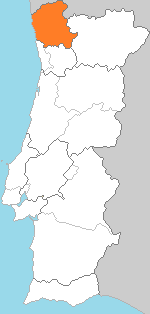
Minho was a former province of Portugal, established in 1936 and dissolved in 1976. It consisted of 23 municipalities, with its capital in the city of Braga. Today, the area would include the districts of Braga and Viana do Castelo. Minho has substantial Celtic influences and shares many cultural traits with neighbouring Galicia in Northwestern Spain. The region was part of the Roman Province and early Germanic medieval Kingdom of Gallaecia. Historical remains of Celtic Minho include Briteiros Iron Age Hillfort, the largest Gallaecian native stronghold in the Entre Douro e Minho region, in North Portugal. The University of Minho, founded in 1973, takes its name from the former province.

The Comunidade Intermunicipal do Ave is an administrative division in Portugal. It was created in 2009. It takes its name from the Ave River. The seat of the intermunicipal community is Guimarães. Ave comprises parts of the former districts of Braga and Vila Real. The population in 2011 was 425,411, in an area of 1,451.31 km².

The Comunidade Intermunicipal do Cávado is an administrative division in northern Portugal. It was created in 2008. It is also a NUTS3 subregion of the Norte Region. The seat of the intermunicipal community is Braga. Cávado comprises part of the former Braga District. The population in 2011 was 410,169, in an area of 1,245.79 km², which makes it one of the most densely populated subregions of Portugal.

Famalicense Atlético Clube (FAC) is a sports club from Vila Nova de Famalicão, Portugal. It has basketball, futsal, rink hockey, volleyball, badminton, snooker, gymnastics and chess departments. The under 16 Basketball team recently reached the final of "Taça do Minho" losing to ATC by one point.

Póvoa de Varzim' is served by a transportation network that employs maritime, aerial and terrestrial travel. The terrestrial access infrastructure is composed of national motorways (freeways), the national roads system, and light rail metro. These infrastructures and the airport, bus terminal, marina and harbour are daily used by commuters.

Póvoa de Varzim, with an area of 82.06 square kilometres, lies between the Cávado and Ave Rivers, or, from a wider perspective, halfway between the Minho and Douro Rivers on the northern coast of Portugal. Although in administrative reforms of 1936, the city was integrated in Douro Litoral, the case for such an administrative integration is arguable, because Póvoa de Varzim is found in a transition region. It has characteristic Minho traditions, historical and demographic bounds with several towns and villages in the region, religiously it is part of Braga archdiocese, and due to that it is perhaps preferable to recognize Póvoa as part of the old region, favouring more Entre-Douro-e-Minho, given its central geographic position in this region.

Pousada de Saramagos is a Portuguese village belonging to the municipality of Vila Nova de Famalicão, in the North of Portugal, more precisely in the region of Minho. The population in 2011 was 2,234, in an area of 2.12 km². It is about 9 km far from its municipal seat.
André Filipe Alves Monteiro, known as Ukra, is a Portuguese professional footballer who plays for C.D. Santa Clara mainly as a winger.
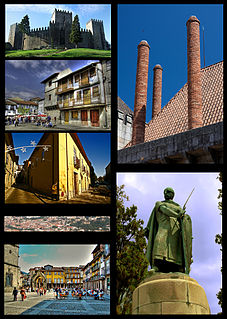
Guimarães is a city and municipality located in northern Portugal, in the district of Braga. Its historic town centre is listed as UNESCO World Heritage Site since 2001, in recognition for being an "exceptionally well-preserved and authentic example of the evolution of a medieval settlement into a modern town" in Europe.
Delfim Ferreira (1888-1960) was an important Portuguese entrepreneur, born in the town of Riba d'Ave, Vila Nova de Famalição. He was the son of the great Portuguese industrial Narciso Ferreira, who, from a small manual mill, built the largest textile enterprise that existed in Portugal in the second half of the nineteenth century.
